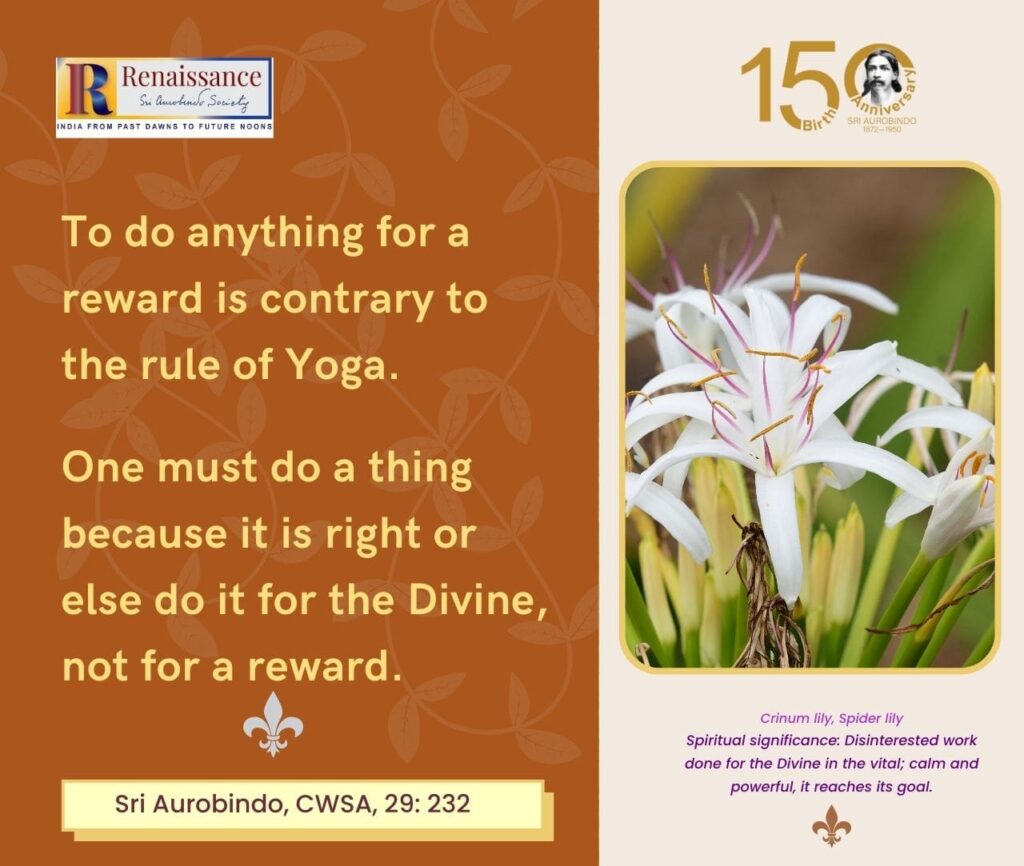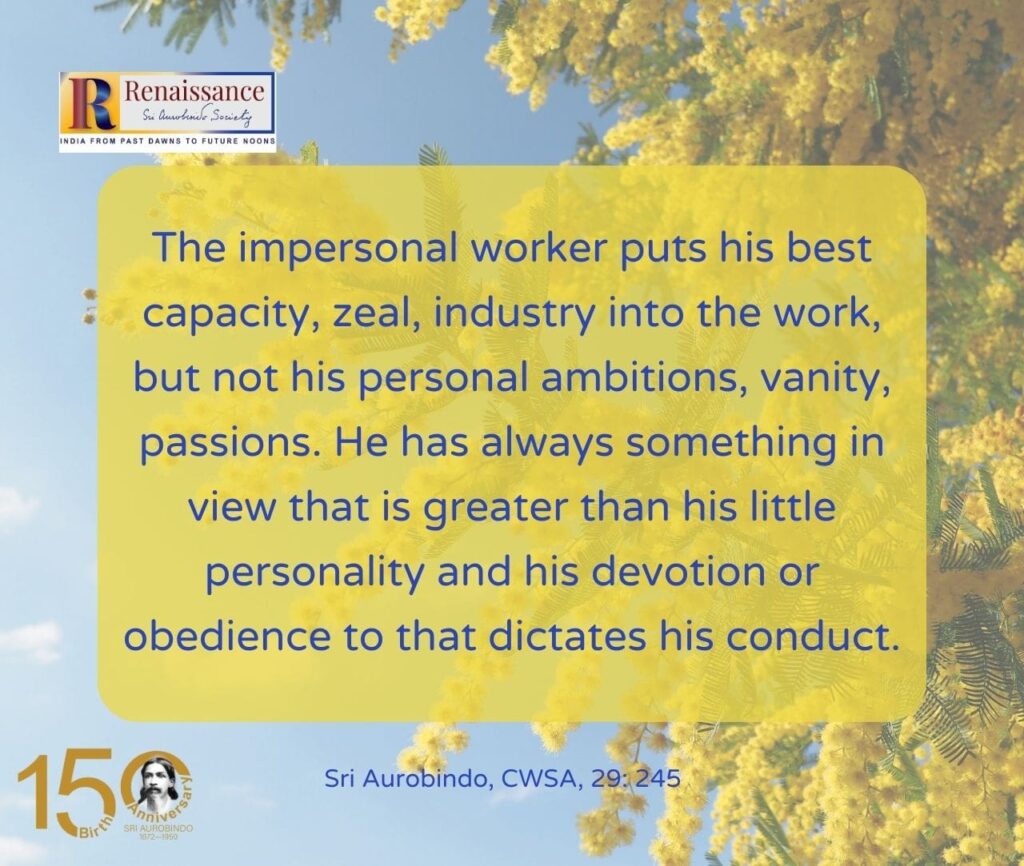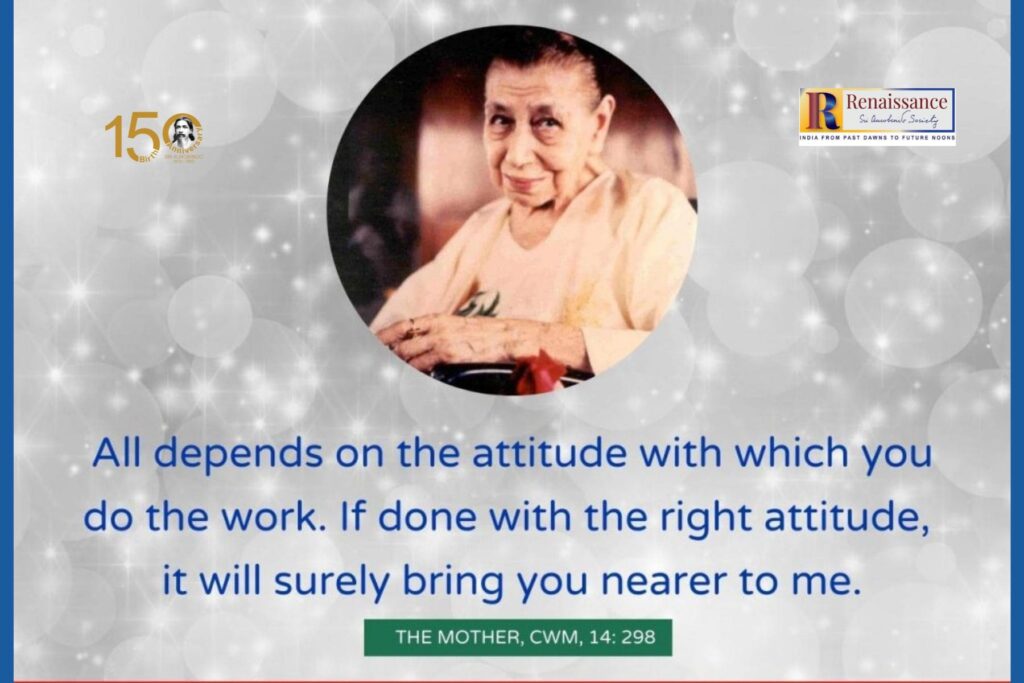Editor’s note: We feature some valuable guidance from Sri Aurobindo on the significance of work in the path of Integral Yoga. These are excerpted from his ‘Letters on Yoga’ (CWSA, Vol. 29).

Work: an Outflow of Energy from the Divine Offered to the Divine
I have always said that work done as sadhana—done, that is to say, as an outflow of energy from the Divine offered to the Divine or work done for the sake of the Divine or work done in a spirit of devotion—is a powerful means of sadhana and that such work is especially necessary in this Yoga.
Work, bhakti and meditation are three supports of Yoga. One can do with all three, or two or one.
There are people who can’t meditate in the set way that one calls meditation, but they progress through work or through bhakti or through the two together. By work and bhakti one can develop a consciousness in which eventually a natural meditation and realisation become possible.

Work without Personal Motives
The only work that spiritually purifies is that which is done without personal motives, without desire for fame or public recognition or worldly greatness, without insistence on one’s own mental motives or vital lusts and demands or physical preferences, without vanity or crude self-assertion or claim for position or prestige, done for the sake of the Divine alone and at the command of the Divine.
All work done in an egoistic spirit, however good for people in the world of the Ignorance, is of no avail to the seeker of the Yoga. [. . .]
***

The difficulties will disappear when you have succeeded in consecrating yourself and your work and business entirely and without any internal division to the Divine.
Men usually work and carry on their affairs from the ordinary motives of the vital being, need, desire of wealth or success or position or power or fame or the push to activity and the pleasure of manifesting their capacities, and they succeed or fail according to their capability, power of work and the good or bad fortune which is the result of their nature and their Karma.
When one takes up the Yoga and wishes to consecrate one’s life to the Divine, these ordinary motives of the vital being have no longer their full and free play; they have to be replaced by another, a mainly psychic and spiritual motive, which will enable the sadhak to work with the same force as before, no longer for himself, but for the Divine.
If the ordinary vital motives or vital force can no longer act freely and yet are not replaced by something else, then the push or force put into the work may decline or the power to command success may no longer be there.
For the sincere sadhak the difficulty can only be temporary; but he has to see the defect in his consecration or his attitude and to remove it. Then the divine Power itself will act through him and use his capacity and vital force for its ends. . . .
The signs of the consecration of the vital in action are these among others:
- The feeling (not merely the idea or the aspiration) that all the life and the work are the Mother’s and a strong joy of the vital nature in this consecration and surrender.
- A consequent calm content and disappearance of egoistic attachment to the work and its personal results, but at the same time a great joy in the work and in the use of the capacities for the divine purpose.
- The feeling that the Divine Force is working behind one’s actions and leading at every moment.
- A persistent faith which no circumstance or event can break.
- If difficulties occur, they raise not mental doubts or an inert acquiescence, but the firm belief that, with sincere consecration, the Divine Shakti will remove the difficulties, and with this belief a greater turning to her and dependence on her for that purpose.
- When there is full faith and consecration, there comes also a receptivity to the Force which makes one do the right thing and take the right means and then circumstances adapt themselves and the result is visible.
To arrive at this condition the important thing is a persistent aspiration, call and self-offering, and a will to reject all in oneself or around that stands in the way.
Difficulties there will always be at the beginning and for as long a time as is necessary for the change; but they are bound to disappear if they are met by a settled faith, will and patience.
***

Karmayoga for Integral Spiritual Life
I do not mean by work action done in the ego and the ignorance, for the satisfaction of the ego and in the drive of rajasic desire. There can be no Karmayoga without the will to get rid of ego, rajas and desire, which are the seals of ignorance.
I do not mean philanthropy or the service of humanity or all the rest of the things—moral or idealistic—which the mind of man substitutes for the deeper truth of works.
I mean by work action done for the Divine and more and more in union with the Divine—for the Divine alone and nothing else. Naturally that is not easy at the beginning, any more than deep meditation and luminous knowledge are easy or even true love and bhakti are easy. But like the others it has to be begun in the right spirit and attitude, with the right will in you, then all the rest will come.
Works done in this spirit are quite as effective as bhakti or contemplation.
- One gets by the rejection of desire, rajas and ego a quietude and purity into which the Peace ineffable can descend;
- one gets by the dedication of one’s will to the Divine, by the merging of one’s will in the Divine Will the death of ego and the enlarging into the cosmic consciousness or else the uplifting into what is above the cosmic;
- one experiences the separation of Purusha from Prakriti and is liberated from the shackles of the outer nature;
- one becomes aware of one’s inner being and feels the outer as an instrument;
- one feels the universal Force doing one’s works and the Self or Purusha watching or witness but free;
- one feels all one’s works taken from one and done by the universal or the supreme Mother or by the Divine Power controlling and acting from behind the heart.
By constant reference of all one’s will and works to the Divine, love and adoration grow, the psychic being comes forward. By the reference to the Power above we can come to feel it above and its descent and the opening to an increasing consciousness and knowledge. Finally works, bhakti and knowledge join together and self-perfection becomes possible—what we call the transformation of the nature.
These results certainly do not come all at once; they come more or less slowly, more or less completely according to the condition and growth of the being. There is no royal road to the divine realisation.
This is the Karmayoga as it is laid down in the Gita as I have developed it for the integral spiritual life. It is founded not on speculation and reasoning but on experience.
It does not exclude meditation and it certainly does not exclude bhakti, for the self-offering to the Divine, the consecration of all oneself to the Divine which is the essence of this Karmayoga are essentially a movement of bhakti.
Only it does exclude a life-fleeing exclusive meditation or an emotional bhakti shut up in its own inner dream taken as the whole movement of the Yoga. One may have hours of pure absorbed meditation or of the inner motionless adoration and ecstasy, but they are not the whole of the integral Yoga.
***

The growth out of the ordinary mind into the spiritual consciousness can be effected either by meditation, dedicated work or bhakti for the Divine. In our Yoga, which seeks not only a static peace or absorption but a dynamic spiritual action, work is indispensable.
As for the Supramental Truth, that is a different matter; it depends only on the descent of the Divine and the action of the Supreme Force and is not bound by any method or rule.
***
Meditation is one means of the approach to the Divine and a great way, but it cannot be called a short cut—for most it is a long and difficult though very high ascent. It can by no means be short unless it brings a descent and even then it is only a foundation that is quickly laid—afterwards meditation has to build laboriously a big superstructure on that foundation. It is very indispensable, but there is nothing of the short cut about it.
Karma is a much simpler road—provided one’s mind is not fixed on the karma to the exclusion of the Divine. The aim must be the Divine and the work can only be a means.
The use of poetry etc. is to keep one in contact with one’s inner being and that helps to prepare for the direct contact with the inmost, but one must not stop with that, one must go on to the real thing. If one thinks of being a “literary man”, a poet, a painter as things worthwhile for their own sake, then it is no longer the Yogic spirit. That is why I have sometimes to say that our business is to be Yogis, not merely poets, painters etc.
***

Meditation, work, bhakti are each means of preparative help towards fulfilment; all are included in this path. If one can dedicate oneself through work, that is one of the most powerful means towards the self-giving which is itself the most powerful and indispensable element of the sadhana.
To cleave to the path means to follow it without leaving it or turning aside. It is a path of self-offering of the whole being in all its parts, the offering of the thinking mind and the heart, the will and actions, the inner and the outer instruments so that one may arrive at the experience of the Divine, the Presence within, the psychic and spiritual change.
The more one gives of oneself in all ways, the better for the sadhana. But all cannot do it to the same extent, with the same rapidity, in the same way. How others do it or fail to do it should not be one’s concern—how to do it faithfully oneself is the one thing important.
Also read:
Equality in the Yoga of Works: The Way of the Gita
Works of Two Kinds
There is no stage of the sadhana in which works are impossible, no passage in the path where there is no foothold and action has to be renounced as incompatible with concentration on the Divine. The foothold is there always; the foothold is the reliance on the Divine, the opening of the being, the will, the energies to the Divine, the surrender to the Divine. All work done in that spirit can be made a means for the sadhana.
It may be necessary for an individual here and there to plunge into meditation for a time and suspend work for that time or make it subordinate; but that can only be an individual case and a temporary retirement.

Moreover, a complete cessation of work and entire withdrawal into oneself is seldom advisable; it may encourage a too onesided and visionary condition in which one lives in a sort of midworld of purely subjective experiences without a firm hold on either external reality or on the highest Reality and without the right use of the subjective experience to create a firm link and then a unification between the highest Reality and the external realisation in life.
Work can be of two kinds—the work that is a field of experience used for the sadhana, for a progressive harmonisation and transformation of the being and its activities, and work that is a realised expression of the Divine. But the time for the latter can be only when the Realisation has been fully brought down into the earth-consciousness; till then all work must be a field of endeavour and a school of experience.

~ Design: Beloo Mehra



